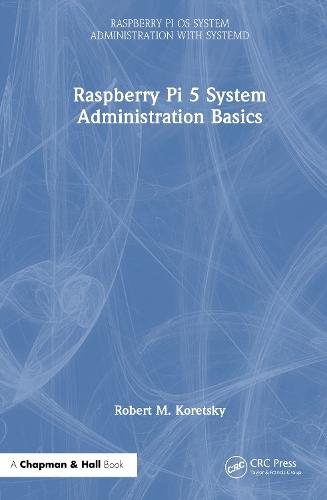Overview
This book covers Raspberry Pi 5 OS concepts and commands that allow a beginner to perform essential system administration and other operations. This is a mandatory set of commands that even an ordinary, non-administrative user would need to know to work efficiently in a character text-based interface (CUI) or in a graphical interface (GUI) to the operating system. Each chapter contains sequential, in-line exercises that reinforce the material that comes before them. The code for the book and solutions to the in-chapter exercises can be found at the following link: www.github.com/bobk48/Raspberry-Pi-5-OS. The first introductory chapter illustrates a basic set of text-based commands which are the predominant means that a system administrator uses to maintain the integrity of the system. User account control is an example of the fundamental integrity aspect of administration, requiring the addition of users and groups while maintaining secure access. Storage solutions involve integrating persistent media such as USB3 SSDs and NVMe drives, ensuring proper file system classification based on physical or virtual media, including NFSv4 and iSCSI setups. The second chapter, which is the core of the book, covers many critical and pertinent system administration commands and facilities. For example, how to attach additional media to the Raspberry Pi 5 and how to install and boot the Raspberry Pi 5 from an NVMe SSD, rather than from the traditional microSD card medium. This chapter also covers many advanced topics to expand the beginner’s knowledge of system maintenance and control. The third chapter shows how system administration is streamlined with systemd, which allows efficient service management. The systemd ""superkernel"" is a powerful initialization and service management framework that has revolutionized Linux system administration. It introduces a structured approach to system control through sub-commands and applications, enhancing system efficiency. At its core, systemd units and unit files serve as essential building blocks, defining system behavior. The fourth chapter gives a basic introduction to the Python 3 programming language, with a complete explication of the syntax of the language, and many illustrative examples.
Full Product Details
Author: Robert M. Koretsky
Publisher: Taylor & Francis Ltd
Imprint: CRC Press
Weight: 0.850kg
ISBN: 9781041099048
ISBN 10: 1041099045
Pages: 363
Publication Date: 11 November 2025
Audience:
Professional and scholarly
,
Professional & Vocational
Format: Hardback
Publisher's Status: Forthcoming
Availability: Not yet available

This item is yet to be released. You can pre-order this item and we will dispatch it to you upon its release.
Author Information
Robert M. Koretsky is a retired lecturer in mechanical engineering, formerly of the University of Portland School of Engineering. He now writes books on UNIX and Linux, particularly for the Raspberry Pi SOC. His hobbies include woodworking and playing early 80s synth pop music.



